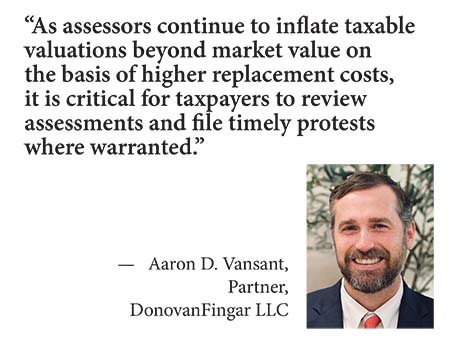Despite the Federal Reserve’s wishful thinking in 2021, inflation has persisted to create an inflationary environment not seen in 40 years. While investors welcome recent cooling trends, the Fed has yet to achieve its 2 percent annual inflation target.
For landlords, tenants and other commercial taxpayers, it’s unsurprising that many tax assessors have increased property tax values in response to inflation. In many jurisdictions, taxable property values have surged regardless of property type or actual market demand.
Taxpayers should not accept higher tax assessments without scrutiny, however. Instead, they should review their assessments to ensure the assessor has considered all factors influencing the property’s value.
Here are several trends for taxpayers to consider when reviewing property tax assessments and preparing to protest inflated valuations:
Cost vs. value
Many assessment officials use the cost approach in mass appraisals of real property for ad valorem tax purposes. Without careful application — including proper classification of improvements, adjustments for depreciation and obsolescence and land adjustments for size and shape differences — the cost approach can lead to assessments inconsistent with a jurisdiction’s market value standard.
While construction costs generally rise over time, some increases may only be temporary. For example, during the COVID-19 pandemic, lumber prices tripled to over $1,500 per thousand board feet but have since returned to pre-pandemic levels below $500. In times of rapidly rising costs, taxpayers should be alert to changes in the assessor’s cost assumptions and be ready to challenge inflated cost-based property values by considering all three approaches to value (income, sales comparison and cost approaches) and their nuances.
In Alabama, countywide cost index changes have driven significant year-over-year tax assessment increases in recent years. These index adjustments, based on county-specific construction cost studies, are typically applied uniformly across all improvements, regardless of property type.
Limited or industry-specific cost data can significantly skew the index, however, leading assessors to overvalue many properties. For example, elevated residential construction costs could result in much higher assessments for office properties struggling with weak demand and plummeting market values.
This is why Alabama lawmakers enacted a bill earlier this year to mitigate inflation-driven property tax hikes by capping annual increases in assessed values for most real property at 7 percent. The new bill takes effect with the 2025 tax year, which has a valuation date of Oct. 1, 2024.
Interest rate ramifications
As the Fed sought to slow inflation, interest rates increased across the board, with the federal funds rate reaching its highest level since the Great Recession. The prime lending rate has remained at a high 8.5 percent for the past 12 months, more than double the 3.5 percent rate it registered in early 2022.
Higher interest rates naturally depress commercial real estate values by squeezing a purchaser’s cash flow and increasing their required return. Higher borrowing costs have affected every real estate sector. Not only is debt service reducing cash flow, but attractive, risk-free bond yields are also driving capitalization rates up (and real estate prices down).
The decline in commercial real estate values has been broad and sustained. Through June 2024, the Green Street Commercial Property Price Index (CPPI) has declined more than 20 percent from its March 2022 peak and remains below pre-pandemic levels. The decline spans all reported sectors, with multifamily, office, retail, healthcare and industrial values all down over the past 12 months.
Rents fall short
The income approach to valuation relies on two primary components: the property’s net operating income and a capitalization rate. In an environment of higher cap rates, a property’s value is likely to suffer unless it can generate additional net income. While rents often increase during periods of inflation, so do expenses.
Increased expenses typically constrain net income immediately, whereas a landlord with an existing lease may not benefit from market rental increases for years. Sometimes expense increases can be passed through to tenants, but this varies greatly by property type and negotiated lease terms.
Even when passed through, additional expenses eventually impact the landlord’s bottom line because those costs factor into the base rental rate tenants are willing to pay upon renewal or in a new lease. Additionally, higher construction costs demand larger tenant improvement allowances, which are not always recovered dollar-for-dollar over the lease term.
Other market headwinds
While inflation has garnered headlines, other economic and industry trends have battered the commercial real estate landscape in recent years. E-commerce has eroded brick-and-mortar retail for two decades, a trend accelerated by the pandemic. With consumers accustomed to ordering items, large and small, from the comfort of their own homes, landlords find it more challenging to re-tenant retail spaces.
Similarly, work-from-home preferences and technology innovations embraced during the pandemic have reshaped the office sector. More than four years after COVID-19 first appeared, and despite near-record-low unemployment, office occupancy has not returned to pre-pandemic levels. Far from it, average physical occupancy (meaning employees in the office, as opposed to leased occupancy) is still only about half of pre-pandemic levels, according to Kastle Systems’ Back to Work Barometer, which tracks keycard and access control data from office buildings in the top 10 U.S. metros.
In many cases, in-place office rents greatly exceed current market averages, and both rents and occupancy are projected to decline as this shift in office space demand shapes terms on new leases.
These are just some of the issues to consider when evaluating a property tax assessment for fairness. As assessors continue to inflate taxable valuations beyond market value on the basis of higher replacement costs, it is critical for taxpayers to review assessments and file timely protests where warranted. Failing to do so could be costlier today than ever.
Aaron D. Vansant is a partner in the law firm of DonovanFingar, LLC, the Alabama member of American Property Tax Counsel, the national affiliation of property tax attorneys. He can be reached at adv@donovanfingar.com.


